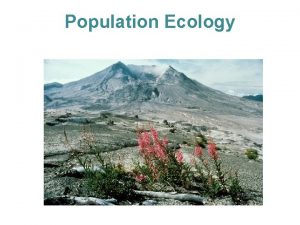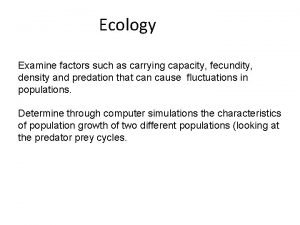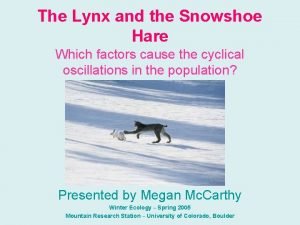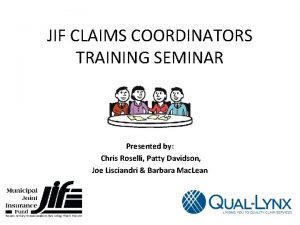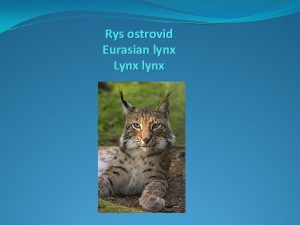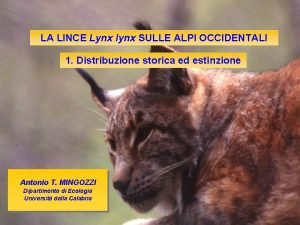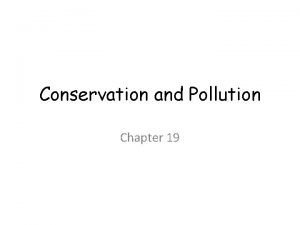Conservation of the Lynx in West and Central









- Slides: 9

Conservation of the Lynx in West and Central Europe Strasbourg, 3 December 2019 Expert conference on the Conservation of the lynx in west and central Europe Urs Breitenmoser & Christine Breitenmoser-Würsten IUCN SSC Cat Specialist Group © L. Geslin

Conservation of the Lynx in West and Central Europe Situation of the lynx IUCN Red List Mapping for regional assessment of Eurasian Lynx (Lynx lynx) in Europe Petra Kaczensky, NINA – June 2018 3 autochthonous populations 11 reintroduced populations Strasbourg, 3 December 2019

Conservation of the Lynx in West and Central Europe Strasbourg, 3 December 2019 Situation of the lynx and challenges for its conservation • Three autochthonous, but fragmented populations: Baltic, Carpathian, Balkan • Three distinct subspecies: L. L. lynx / carpaticus / balcanicus • 11 reintroduced populations, at least 2 additional projects ahead • All populations (autochthonous and reintroduced) need conservation interventions • Reintroductions and reinforcement (e. g. genetic remedy) need source animals • “Naïve” releases as in the 1970 s and 1980 s are no longer possible. Today, we need to consider: o Phylogenetic and genetic aspects o Health considerations o Animal welfare regulations Lynx release in central Switzerland 1973 Ø Many new lynx projects in recent years (e. g. LIFE+) Ø Need for common goals, approaches and protocols Ø Need for coordination and synchronisation

Conservation of the Lynx in West and Central Europe Strasbourg, 3 December 2019 Situation of the lynx and challenges for its conservation Approach: Conference with 50 experts from all continental range countries: • Review of conservation status of all continental populations • Presentations on topical themes, e. g. connectivity, genetics, disease… • Workshop (plenary & working groups) to discussion recommendations Expert workshop in Bonn, 17– 19 June 2019

Conservation of the Lynx in West and Central Europe Strasbourg, 3 December 2019 Situation of the lynx and challenges for its conservation Approach: 2000 Status review and strategic update for Western & Central Europe with practical recommendations on standards, procedures, and protocols.

Conservation of the Lynx in West and Central Europe Strasbourg, 3 December 2019 Strategic Preamble Objectives: 1. To conserve all autochthonous populations, […] and to safeguard distinct evolutionary significant units of the Eurasian lynx on continental Europe. 2. To conserve all reintroduced populations of Eurasian lynx and to promote […] further reintroductions […] or “stepping stones” contributing to the functioning of a larger metapopulation. 3. To foster the natural or assisted connectivity between populations of the same phylogenetic units (e. g. subspecies or ESUSs) […]. 4. To develop and implement management measures addressing the interactions concerning lynx in the human-dominated, multi-purpose landscapes of Europe. 5. To generate and provide objective information through monitoring and research […] to take the necessary measures to prevent local extinctions. 6. To reduce human-induced mortality of lynx, esp. by illegal killing and vehicle collisions.

Conservation of the Lynx in West and Central Europe Strasbourg, 3 December 2019 Recommendations 1: Phylogenetic delineation Distribution of Eurasian lynx Lynx lynx on continental Europe 2012– 2016 Permanent presence (colours = populations) Sporadic presence Autochthonous population Reintroduced population or stepping stones Proposed delineation between ESUs Northeast European lowland population L. l. lynx Baltic states, lowland Poland, all potential areas north of the German “Mittelgebirge” Carpathian lynx populations L. l. carpathicus Carpathians, Alps, northern Dinaric Range, continental secondary mountain chains Balkan lynx population L. l. balcanicus Southern Dinaric Range, Rhodope Range, Greece

Conservation of the Lynx in West and Central Europe Strasbourg, 3 December 2019 Recommendations 2– 7: 2. Metapopulations of lynx in continental Europe and connectivity ® Establish and maintain a large continental metapopulation per ESU 3. Concepts for monitoring of the conservation status of lynx populations ® Standardise and synchronise demographic monitoring across Europe 4. Principles for the genetic monitoring and management of lynx populations ® Standards for genetic monitoring and genetic interventions (reinforcement) 5. Source populations for reintroductions or reinforcement ® Autochthonous population and correctly bred and managed EAZA lynx 6. Protocols for translocation of lynx ® Standards for capture, health-check, quarantine, and transport 7. Cooperation in lynx conservation in Europe ® Establish a permanent Eurasian lynx expert working group affiliated with the IUCN SSC Cat SG and LCIE Ø The recommendations base on the current legislation and consider the present conservation status of all populations, the up-to-date information on genetics and health, the newest available monitoring techniques, and the combined experience of the participants of the Bonn conference.

Conservation of the Lynx in West and Central Europe Strasbourg, 3 December 2019 Recommendations • Submit to Standing Committee of the Bern Convention for review and endorsement • Publish Proceedings and Expert Recommendations as a Special Issue of Cat News • Submit to International Conventions and to the relevant agencies of all continental Range Countries Thank you for your support!

